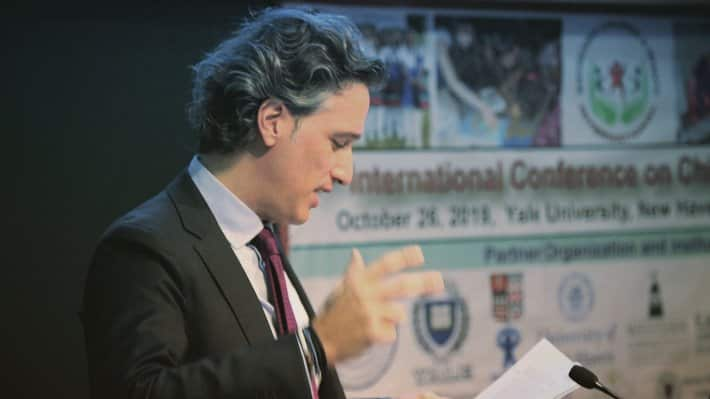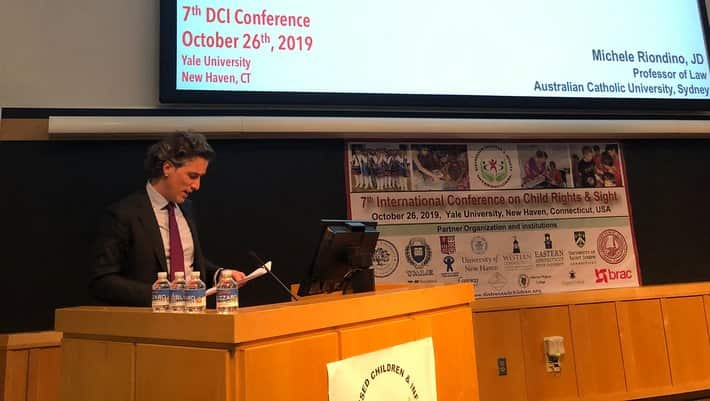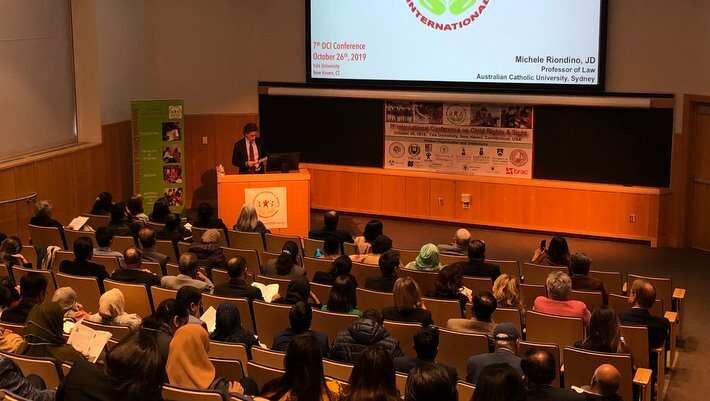The four core principles of the Convention concern non-discrimination include non-discrimination; adherence to the best interests of the child; the right to life, survival and development; and the right to participate.
In 30 years many steps have been taken to protect the rights of children, but the road ahead is still long and the situation is different from country to country. As Professor Michele Riondino, also Director of Canon Law Centre at ACU Law School, recalls citing religious leader Dietrich Bonhoeffer who participated in the Nazi resistance: "the moral sense of a country is measured by what it does for its children".
Even if the numbers are falling, it should be emphasized that according to data from the International labor Organization (ILO) today there are still at least 150 million children, between the ages of 5 and 11, that over the world are being exploited.
Professor Michele Riondino was recently a guest speaker at Yale University's International Distressed Children and Infants conference. Below you find the full text of his speech.
Below you find the full text of his speech.

Source: Courtesy of prof. Michele Riondino
The 30th anniversary of the Convention on the Rights of the Child
The following text refers to the keynote address that Professor Michele Riondino gave on the 26th October at Yale University, on the occasion of DCI’s 7th International Conference on Child Rights.
Introduction
First, let me thank Prof. DeBroff and Dr. Hoque for the kind invitation. I am extremely honoured to speak, for the third time, in this prestigious university whose reputation goes far beyond the geographical borders of this country. I am also particularly delighted that our conference brings together scholars, experts and advocates of children’s rights from different continents. I am sure that this important meeting, hosted here every two years, will contribute to the development and the protection of many children around the world. As you can understand from the title of my paper, I will focus my attention on two main topics: the contribution of the International Labour Organization (hereinafter ILO), established as an agency of the League of Nations 100 years ago, and the Convention on the Rights of the Child (hereinafter CRC), on its 30th anniversary.
The rights of the Child: a brief overview
During the past century, the protection of children's rights has been one of the biggest challenges for contemporary societies. And although one of the aims of the CRC was to positively affect the juridical regulation of states, both individually and corporately, as well as in other public spheres, such efforts have not always had a satisfactory outcome. We are not morally free to ignore these failures, and whatever our good intentions toward social and cultural contexts beyond our own, we overlook grave and alarming contradictions on the rights of the Child much closer to home.
Everyone knows there are too many neglected children everywhere, some are abandoned even within their own families. There are children abused in a physical but also in a psychological way, not to mention through the terrible and growing forms of violence that are ignored. Children are forgotten and defenceless because their fundamental rights are not recognised by educational agencies that have marginalised them, by public services that are negligent, and by families that are emotionally absent, or unable to provide an environment where the child can be adequately educated. There are invisible children: migrants and minors who are unaccompanied, and because of this, their childhood is not acknowledged and is wounded on a daily basis; infants who at times are tolerated but hardly ever truly accepted and integrated. There are also those children whose childhood has been denied because they are overburdened with heavy responsibilities too quickly and at a vulnerable age. Many families of children with disabilities leave these children alone. Another factor that plays into this disability is their personal encounter with other families that don't share the same burdens, more so since they struggle to socialise with children of the same age in their neighbourhoods or in the schools they attend. In other words, their challenges pervade every sphere of their life. In this regard there is no doubt that the several international declarations and conventions from the past century have helped limit such violations of children’s rights as they recognise that children have particular rights and interests, according to their conditions as trainees.
The International Labour Organization
The initiative of having taken, within the international sphere, a commitment to protect children dates back to the oldest existing international organisation, the International Labour Organization (ILO), from its establishment in 1919 at which time it supported the ratification by States of Convention No. 5. This ILO Convention set the minimum age at fourteen for children who work in industrial environments, notwithstanding some derogations or restrictions found within the aforementioned Convention.
Eventually, the minimum age was later raised to fifteen years old as expressly foreseen. This is according to ILO Convention No. 138 (1973) on the Minimum Age for admission to Employment. The ILO’s tenacious commitment over the years is also particularly evident in the Convention No. 182 (1999), aimed at abolishing the worst forms of labour exploitation of children, including illegal activities and the recruitment of minors for armed conflict. Both Conventions (No. 138 and No. 182) distinguish between unacceptable “child labour” and “hazardous child labour” that are to be abolished, and “child work” that may contribute to a child’s healthy development. The Minimum Age Convention states in its Preamble: “National legislation should fix a minimum age or ages at which children can enter into different types of work”. Although the Convention states that the general minimum age should not be less than the age for completing compulsory schooling, and in any event should not be less than 15 years of age with the ultimate aspiration being 16 years, it offers some flexibility for developing nations that are unable to meet this target. It allows them to set a minimum age of 14 years old until they are able to comply fully with the Convention. Light work may be permitted for children who are 12 years old and older, and non-hazardous work is allowed for children who are 15 years old or with an older age. Hazardous work and the worst forms of child labour are never allowed for children.
In Europe, for example, Belgium, Italy, Germany and Spain had already been Parties to the ILO Convention No. 138 for several years before the CRC was established. By contrast, many Western European countries, such as France, Sweden and Denmark, became Parties to ILO Convention No. 138 only after having ratified the CRC.
According to data released by the ILO, on 12 June, on the occasion of the World Day against Child Labour, today more than 150 million children around the world are categorised as child labourers. The region with the highest level of exploitation of children is Africa, with more than 72 million children involved in Child labour. The Asia Pacific ranks the second highest. The ILO’s Global Estimates on Child Labor, published in Geneva in 2017, note that attempting to address child labour without considering the economic and social forces that produce it is unlikely to be successful. It also recommends that policy responses to child labour need to be integrated into broader national development efforts and adopted to local circumstances. The UN Convention on the Rights of the Child
The UN Convention on the Rights of the Child

Source: Courtesy of prof. Michele Riondino
Working together to defend the most vulnerable citizens, international standards have made further and significant, though limited, progress. Let us consider, for example, the Declaration of the Rights of the Child. Adopted in Geneva in 1924, it recognised in the international juridical system, for the first time, some fundamental rights of the child with the goal of children’s harmonious growth and development. This led to the UN Declaration of the Rights of the Child, which was also unanimously approved by the General Assembly of the United Nations in New York in 1959.
Both declarations, by their own nature, are characterised by a value that is merely programmatic, devoid of binding legal force for the States. But the very principles enshrined in the two international treaties cited above, although not exigible within state sectors (according to their nature as non-binding declarations), have prompted the development whereby some concrete values inherent in different legal systems have resulted in gradual recognition of the rights of children.
The evolution outlined, as with the long steps taken from the legislation under review, have proved the way for the conclusion of international agreements that would bind States, such as the aforementioned United Nations Convention on the Rights of the Child. The CRC, adopted in New York in 1989, of which we celebrate next month the 30th anniversary, gathers in a unified form the civil, political, economic, social and cultural rights that must be recognised at a developmental age. The general principle, which is the most important interpretive key of all the legal institutions for the protection of children, coincides with the highest interests of the child, which article No. 3 of the CRC explicitly mentions. In fact, it states: “In all actions concerning children, whether undertaken by public or private social welfare institutions, courts of law, administrative authorities or legislative bodies, the best interests of the child shall be a paramount consideration”. It seems clear, from the wording of this statement, that the criteria of the primary interests of children are aimed at specifically regulating. Indeed, we can affirm that the obligation to guarantee the real protection of the rights of every child must be pursued even in cases that are in clear opposition to the interests of adults. This means that adults must be precluded from taking any action to limit the development of any child.
Reading and reflecting on the article No. 3 of CRC, inevitably reminds us of that event of November 20, 1989, which in a sense commemorates the bicentenary of the Universal Declaration of the Rights of Man and of the Citizen, set up by France’s National Constituent Assembly in 1789. The Magna Carta of children’s rights was presented to the UN Assembly for approval. It is a legislative instrument composed by 54 articles, ratified by the majority of the Member – States. This, as we know, radically modified the juridical concept underpinning the status of the child within the various legal systems. In the light of this new covenant amongst People and Nations, the active subject of rights must be considered, as opposed to a passive recipient of mere protection. Nowadays, there are 196 States that have ratified the Convention. In fact, the last country that ratified the Convention was Somalia in 2015 after a long and difficult process, and thanks to the commitment and efforts of international diplomacy, can boast of having successfully reached this noble goal. Today’s conference, the seventh in the series, along with the university’s authorities who are hosting and sponsoring this event will, I hope, encourage the United States of America to ratify, as soon as possible, the Magna Carta of children’s rights.
The right of every child to be protected against any kind of violence, exploitation, abuse and negligence is explicitly endorsed by the combination of various articles in the CRC. See, in this regard, articles No. 19, 28 and 37. In an area closely linked to the protection of the child against any type of labour exploitation, we can find the main reference in article No. 32. According to the CRC it is required that all States (or Governments) have to protect children from all forms of economic exploitation and from performing any work that is likely to be hazardous or to interfere with the child’s physical, mental, spiritual, moral or social development. This is, once again, in the name of the aforementioned general principle of the best interest of the child.
We can finally affirm, clearly, that for the first time in the CRC, emphasis has been placed on the need to promote the harmonious development of the child’s personality whose legitimate aspirations, potential and natural inclinations, are to be respected by adults and by the social community. In this perspective, there emerges a clear reminder that every adult should commit him/herself not only to contribute to the child’s growth but, in particular, to the child’s personal potential, limiting fear and incertitude in a way that renders more easily children’s mature and responsible integration into society. As we already know, in 2015 the wider Agenda of the UN adopted a set of Sustainable Development Goals (SDGs), including Target No. 8.7, calling for the abolition of all the worst forms of child labour immediately, and for all other forms of child labour to be eradicated by 2025.
Conclusion
In conclusion, we can stress three main words: trust, protection and willingness. They have to be fundamental prerogatives to guarantee qualities that will help every child in the solid development and construction of his destiny not only as a human being, but as a responsible citizen who is able to meet the diverse and demanding challenges which will confront every person throughout the life. Therefore, to ensure protection of the rights and interests of those who seek to live life to its fullest, more than ever becomes a priority from which no human being can feel exonerated. It is only in embracing this dutiful challenge that we can pass from a theoretical level into a practical one. The duty for us adults to recognise a moral leadership to the legitimate interests of the child does not derive, in the final analysis, from a mere compassion for children, that is, from considering every child as subjects who are constitutionally weak. Rather comprehending that their weakness and innocence create an explicit duty on the part of whoever is preparing to work with them. Only in this way we can help them to flourish, and never to confine their legitimate interests.
More than a quarter of a century has passed from the adoption of CRC by the UN General Assembly. We should not wait another 30 years to give full effect to the principles embodied in the Convention. What is at stake is not our own good, but the present and future good of all humanity.
My wish is that the international and national commitments, but also the efforts of scholars, experts and practitioners who deal with childhood and adolescence, continue and reinforce the direction set by the international legislation to which I briefly referred. Only in this way the Jean – Jacques Rousseau's admonition, written in 1762 in his famous book “Emile, or On Education”, according to which “Nature wants children to be children before men”, will be followed up by everybody.
* Professor of Canon Law and Children’s Rights at ACU Law School and Director of Canon Law Centre.

Source: courtesy of prof. Michele Riondino




